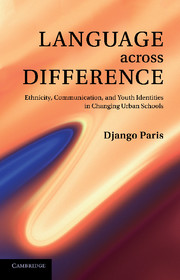Book contents
- Frontmatter
- Contents
- Figures
- Tables
- Acknowledgments
- 1 Beginnings: shouts of affirmation from South Vista
- 2 ‘Spanish is becoming famous’: youth perspectives on Spanish in a changing youth community
- 3 ‘True Samoan’: ethnic solidarity and linguistic reality
- 4 ‘They’re in my culture, they speak the same way’: sharing African American Language at South Vista
- Interlude : on oral language use, research, and teaching in multiethnic schools
- 5 ‘You rep what you’re from’: texting identities in multiethnic youth space
- 6 Making school go: re-visioning school for pluralism
- Appendix: Notes on methodology in cultural studies of language across difference
- Notes
- References
- Index
5 - ‘You rep what you’re from’: texting identities in multiethnic youth space
Published online by Cambridge University Press: 05 August 2011
- Frontmatter
- Contents
- Figures
- Tables
- Acknowledgments
- 1 Beginnings: shouts of affirmation from South Vista
- 2 ‘Spanish is becoming famous’: youth perspectives on Spanish in a changing youth community
- 3 ‘True Samoan’: ethnic solidarity and linguistic reality
- 4 ‘They’re in my culture, they speak the same way’: sharing African American Language at South Vista
- Interlude : on oral language use, research, and teaching in multiethnic schools
- 5 ‘You rep what you’re from’: texting identities in multiethnic youth space
- 6 Making school go: re-visioning school for pluralism
- Appendix: Notes on methodology in cultural studies of language across difference
- Notes
- References
- Index
Summary
django: Here you have “True Hamoz” {True Samoan}. Tell me why you write the things down. Why do you write it on there? (I point to the text Ela has written inside the commercial Superman logo on her backpack)
ela: I don’t know. I like writing stuff all over my backpack, you know, “Samoan.”
django: But why do you write “Samoan?”
ela: Because I love where I grew up at …
(March 15, 2007)Identity texts as an analytic lens
The youth of South Vista wrote texts on their backpacks, clothing, and skin. They sent texts from cellular phones and over online spaces. And many authored and performed texts as youth emcees. These texts pulsed through the everyday canvases of youth space defining who was a member of particular groups and who was not in a textual argument of solidarity, exclusion, crossing, and sharing. This textual argument mirrored through the written word the processes of oral language at South Vista. I came to understand these cultural inscriptions as identity texts, an analytic category that allowed me to parse out the workings of various types of text while seeing them also as a whole textual system. I use the term identity texts to refer to youth space texts inscribing ethnic, linguistic, local, and transnational affiliations on clothing, binders, backpacks, public spaces, rap lyrics, and electronic media. These texts were bound together by three factors: they indexed identities as members of particular groups, they were unsolicited literacy acts not officially evaluated by school, and all youth at South Vista participated in creating them.
- Type
- Chapter
- Information
- Language across DifferenceEthnicity, Communication, and Youth Identities in Changing Urban Schools, pp. 126 - 162Publisher: Cambridge University PressPrint publication year: 2011

